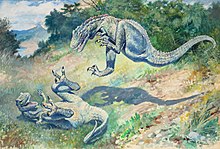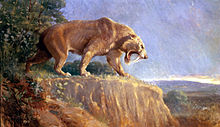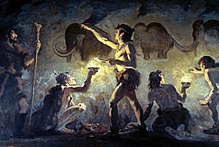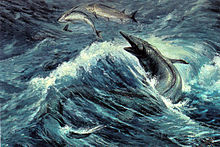Charles R. Knight
Charles R. Knight | |
|---|---|
Manhattan, New York | |
| Nationality | American |
| Known for | Painting |
Charles Robert Knight (October 21, 1874 – April 15, 1953) was an American wildlife and paleoartist best known for his detailed paintings of dinosaurs and other prehistoric animals. His works have been reproduced in many books and are currently on display at several major museums in the United States. One of his most famous works is a mural of Tyrannosaurus and Triceratops, which helped establish the two dinosaurs as "mortal enemies" in popular culture. Working at a time when many fossil discoveries were fragmentary and dinosaur anatomy was not well understood, many of his illustrations have later been shown to be incorrect representations. Nevertheless, he has been hailed as "one of the great popularizers of the prehistoric past".
Biography
Early life
Knight was born in Brooklyn, New York City on October 21, 1874.
As a child, Knight was deeply interested in nature and animals, largely thanks to his father's passion for the outdoors and spent many hours copying the illustrations from his father's natural history books. His father also took him on trips to the American Museum of Natural History which fueled his knowledge for nature. Knight began drawing when he was around five or six years old. In later years he abandoned the practice of drawing from books altogether, and instead drew from life.
Though

In his free time, Knight visited the American Museum of Natural History, attracting the attention of Dr. Jacob Wortman, who asked Knight to paint a restoration of an extinct hoofed mammal,
After a tour of Europe by visiting many museums and zoos, Knight returned home where he met two key people in the history of paleontology, Edward Drinker Cope and Henry Fairfield Osborn. Osborn then created the new Department of Vertebrate Paleontology at AMNH and he had a revolutionary idea to put entire skeletons of dinosaurs on display. Originally, fossils were kept out of the public's eye and were then stored in store room shelves for study by scientists only. But Osborn had the idea of creating these new exhibits for the public. He assembled a team of himself, Knight, and Dr. William Diller Matthew. Knight sketched the skeletons while Matthew and Osborn mounted them. Cope died shortly after Knight met with him after he became impressed by Knight's sketches.
The museum was amazed by his watercolor paintings and the successful exhibits. J. P. Morgan (the famous banker), who was a patron to the museum, helped finance the restorations of prehistoric life. His paintings were hugely popular among visitors, and Knight continued to work with the museum until the late 1930s, painting what would become some of the world's most iconic images of dinosaurs, prehistoric mammals, and prehistoric humans.

One of Knight's best-known pieces for the American Museum of Natural History is 1897's Leaping
Knight's work for the museum was not without critics, however. Although he spent considerable time at zoos studying the movements and habits of living animals,[2] many curators argued that his work was more artistic than scientific, and protested that he did not have sufficient scientific expertise to render prehistoric animals as precisely as he did. While Knight himself agreed that his murals for the Hall of the Age of Man were "primarily a work of art," he insisted that he had as much paleontological knowledge as the museum's own curators.[3]
In 1900, Knight married Annie Humphrey Hardcastle and had a daughter named Lucy.
Nationwide attention

After Knight established a reputation at the American Museum of Natural History, other natural history museums began requesting paintings for their own fossil exhibits. In 1925, for example, Knight produced an elaborate mural for the

Knight's work also found its way to the
Although Knight's interest in animals and animal anatomy is well known, Knight also had an interest in botany. He often traveled to Florida and used the palm trees for his prehistoric paintings.
While making murals for museums and zoos, Knight continued illustrating books and magazines, and became a frequent contributor to National Geographic. He also wrote and illustrated several books of his own, such as Before the Dawn of History (Knight, 1935), Life Through the Ages (1946), Animal Drawing: Anatomy and Action for Artists (1947), and Prehistoric Man: The Great Adventure (1949). Additionally, Knight became a popular lecturer, describing prehistoric life to audiences across the country.
Eventually, Knight began to retire from the public sphere to spend more time with his grandchildren, mostly his granddaughter Rhoda, who shared his passion for animals and prehistoric life. In his later years, his eyesight began to deteriorate and he painted less often. From 1944 to 1946 he painted his final series of paintings at the National History Museum of Los Angeles County.
In 1951, he painted his last work, a mural for the Everhart Museum in Scranton, Pennsylvania. Two years later, on April 15, 1953, Knight died in New York City.
Legacy

Knight has been hailed as "one of the great popularizers of the prehistoric past", and as having influenced generations of museum-goers.

Because Knight worked in an era when new and often fragmentary fossils were coming out of the American west in quantity, not all of his creations were based on solid evidence; dinosaurs such as his improbably-adorned

The late Stephen Jay Gould was one of Knight's most well-known fans, notably refusing to refer to Brontosaurus as "Apatosaurus" because Knight had always referred to the creature with the former name.[5] Gould writes in his 1989 book Wonderful Life, "Not since the Lord himself showed his stuff to Ezekiel in the valley of dry bones had anyone shown such grace and skill in the reconstruction of animals from disarticulated skeletons. Charles R. Knight, the most celebrated of artists in the reanimation of fossils, painted all the canonical figures of dinosaurs that fire our fear and imagination to this day".[9] Other admirers have included
In 2012, a book about Knight and his art written by Richard Milner titled Charles R. Knight The Artist Who Saw Through Time was published. It starts with an introduction by Knight's granddaughter Rhoda.[12]
A website dedicated to Knight was created and maintained by Rhoda and features many of his paintings.[13]
An homage to the painter was also made in the 1998 IMAX feature film, T-Rex: Back to the Cretaceous, in which he was portrayed by actor Tuck Milligan.
Works




Knight's works are currently included as part of the permanent collections of these colleges, libraries, museums, and zoos:
- Philadelphia, Pennsylvania)
- American Museum of Natural History (New York, New York)
- Bethune-Cookman College (Daytona Beach, Florida)
- Bronx, New York)
- Carnegie Museum of Natural History (Pittsburgh, Pennsylvania)
- The Dinosaur Museum (Blanding, Utah)
- Everhart Museum (Scranton, Pennsylvania)
- Field Museum of Natural History (Chicago, Illinois)
- Florida Museum of Natural History (Gainesville, Florida)
- Illinois State Museum (Springfield, Illinois)
- Mesa Southwest Museum (Mesa, Arizona)
- Museum of the Earth (Ithaca, New York)
- Washington, DC)
- National Zoo (Washington, DC)
- Natural History Museum of Los Angeles County (Los Angeles, California)
- Princeton University (Princeton, New Jersey)
- Science Museum of Minnesota (Saint Paul, Minnesota)
- Sebring Public Library (Sebring, Florida)
- Yale Peabody Museum of Natural History (New Haven, Connecticut)
In addition, a touring exhibit, Honoring the Life of Charles R. Knight, was launched in 2003 and has visited several locations throughout the United States.
Publications
- Before the Dawn of History, 1935
- Life Through the Ages, 1946
- Animal Drawing: Anatomy and Action for Artists, 1947
- Prehistoric Man: The Great Adventurer, 1949
- Charles R. Knight, Autobiography of an Artist, 2005
See also
- Paleoart
- Wildlife art
- Zdeněk Burian
Notes
- ^ Stout 2005, p. ix.
- ^ Graslie, Emily (25 April 2018). "Paleoart: Painting the Land Before Time". Field Museum of Natural History. Retrieved 16 October 2021.
- ^ Cain, Victoria. "'The Direct Medium of the Vision': Visual Education, Virtual Witnessing and the Prehistoric Past at the American Museum of Natural History, 1890-1923." Journal of Visual Culture, 2010, 9: 284, pp. 292-298.
- ^ "Charles Knight: Prehistoric Visions of a Beloved Muralist" 2002 Field Museum, In the Field article by Alexander Sherman
- ^ a b Butler, Emily Y. (October 2005). "Interview with Rhoda Knight Kalt" (PDF). Geospectrum. 5 (1). American Geological Institute. Archived from the original (PDF) on 2011-06-08.
- .
- ^ Stout 2005, p. xi. "There was scarcely a dinosaur book published in the first sixty years of the 20th century that did not include examples of Knight's work."
- ^ Marcel Delgado: The Man Who Made Monsters Retrieved October 1, 2009.
- ^ a b "Welcome to the World of Charles R. Knight".
- ^ Morales, Bob (1999). "The PT Interview: Gregory S. Paul" (PDF). The Prehistoric Times (35). Retrieved August 21, 2016.
- ^ Curley, Vince J.J. (2006). "The Prehistoric Times Interview:Gregory S. Paul" (PDF). The Prehistoric Times (75). Retrieved August 21, 2016.
- S2CID 161289346.
- ^ Kalt, Rhoda Knight (2002). "The World of Charles R. Knight".
References
- Heilmann, G. (1926). The Origin of Birds. London, H.F. & G. Witherby.
- Paul, G.S. (1996). The art of Charles R. Knight. Scientific American 274 (6): 74-81.
- Cain, V. (2010), "'The Direct Medium of the Vision': Visual Education, Virtual Witnessing and the Prehistoric Past at the American Museum of Natural History, 1890-1923", Journal of Visual Culture, 9 (3): 284–303, S2CID 192988300
- Stout, William (2005). Introduction. Charles R. Knight: Autobiography of an Artist. By Knight, Charles Robert. G.T. Labs. pp. ix–xiii. ISBN 978-0-9660106-8-8.
- For Knight's dark side see: Brian Regal, Henry Fairfield Osborn: Race and the Search for the Origins of Man (Ashgate, 2002).
External links
- The World of Charles Knight, a website maintained by Knight's granddaughter Rhoda Knight Kalt (includes most of his paintings)
- Charles R. Knight biography at Field Museum website
- Charles R. Knight biography at American Museum of Natural History website
- Time Traveler: The Art of Charles R. Knight; March 26, 2012; Scientific American
